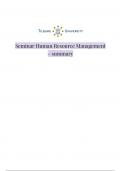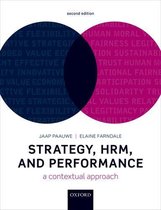Seminar Human Resource Management
- summary
, SHRM - summary Emma Hamm, 2078889
The multiple choice exam
Video lecture 1: strategy and the interplay with HRM
CHAPTER 2
PAAUWE/FARNDALE: STRATEGY, HRM AND PERFORMANCE: A CONTEXTUAL
APPROACH
● Link between Strategy, HRM and Performance
● What do we mean by performance?
○ Broad meaning! Achieving the goals of the organisation, productivity, meet
standards, implementation of strategy, wellbeing, satisfaction
● We aim for a balanced approach
→ firm, people, society at large fairness, sustainability
○ look at the business side (profit, market share,...) + what is in it for
employees, what is the local footprint,...
○ balanced approach also looks a the different levels;
individual level, organisational level, sector level, national level, international
level (e.g. ILO: international labor organization)
→ clients, employees (organisational level)
→ economy, country (society level)
● No blueprints customized approach
There should not be a ‘standardized’ approach in an organisation, but customized.
the HR quality should fit the organisation and the team
Developing context sensitivity
● What do we mean by context??
E.g. chicken slaughter in contrast with an accountancy office
● principles in chicken slaughter: safety, hygiene, experienced people. very
efficient working
● principles in an accountancy office: professional in numbers, high quality,
deadlines, accuracy, teamwork, honesty, high educated
→ you have to take this into account forming HR. very important to be aware to the
sensitive of the company
HR ‘FIT’
4 forms of fit at the organisational level:
1. Environmental ‘fit’: HR strategies & environment
→ demands by the government, bargain agreements,...
2. Strategic ‘fit’ (vertical): HR strategies & business strategy
→ about alignment between corporate strategy and HR policies
3. Internal ‘fit’ (horizontal): HR practices
→ whether separate HR practices are reinforcing each other, should be in line
4. Organisational ‘fit’: HR systems & other systems
→ the resource system should fit the technology in the organisation. IT software,...
5. Other fit:..? → combine theories, make a new framework in the seminar!
1
, SHRM - summary Emma Hamm, 2078889
at individual level: person-job fit, person-organisation fit (macro micro fit)
→ CHAPTER 3: all different forms of FIT
Whole book is aimed at building and applying this framework;
- you take into account… the competitive mechanisms (strategic fit),
social/political/legal context (institutional/environmental fit), heritage mechanisms
(organizational fit)
- the way different HR practices are combined and reinforce is all about horizontal fit
- the more fits, the better you have aligned your HR management system
internal/externally
TRADITIONAL VS. STRATEGIC HRM
2
, SHRM - summary Emma Hamm, 2078889
in reality: both types of HR managers are still present. The focus in this program will be on
the strategic role of HR.
How can we bring added value to the organisation? How can we bring specific knowledge so
the line-managers take into account your knowledge?
https://slideplayer.com/slide/5957576/
WHAT IS STRATEGY ALL ABOUT?
● Distinguish business and corporate strategy
● Different business, different operations, different units,... Which one should fit with
HRM?
→ At the business level. Here people are working on a specific product/service in a
specific market. there should be an overall alignment.
(→ Corporate strategy is more about the principles, ethics, culture you want to
emphasize)
● In the book of Mintzberg: different meanings of strategies: plan, pattern, ploy,
position, perspective, see also schools of strategic thinking
● Outside in (Porter) and inside out (RBV) approaches
○ outside in: look at the market, what do we need, what people, what resource
○ inside out: what kind of people, skills, resources do we have? How do we
use this in the market?
→ best to use both!
TABLE 3.1 OUTSIDE-IN VERSUS INSIDE-OUT PERSPECTIVE ON STRATEGY
Characteristics of both perspectives. you can also take attention to the characteristics, the
tensions between shareholders, the formal/informal approach,
3






